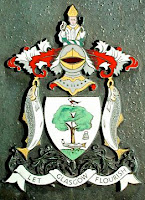The name of Glasgow, in Scotland, is derived from the Celtic 'Glas ghu' which means 'dear green place'. It's not so green today, but for many it still remains dear. It's patron Saint is St. Mungo who dedicated his life to Christianity in the mid 6th century.
It's said that he visited a holy man named Fergus. Fergus had been told he would survive until he met the person who would convert the whole region to Christianity. Thus soon after he received Mungo he passed away.
Mungo gently placed his body onto a cart drawn by two bulls. The bulls would stop at the place ordained by God. Where he cart stopped, Furgus was buried and the Church that was to become Glasgow Cathedral was also founded there.
There is also the legend of King Rydderach who gave his wife, Queen Langeoreth a gold ring. She, in turn, gave the ring to a handsome Knight. The king was informed of this and found the knight sleeping on the bank of the river Clyde. He took what he thought to be the same ring from the soldier's finger, and threw it into the river.
To punish the queen he then asked her why she wasn't wearing the ring he had given her. He challenged her to bring it to him. The queen sought out the knight to retrieve the ring. He told her that it had mysteriously disappeared whilst he was sleeping. The knight then confessed to St. Mungo asking him for forgiveness and help. St. Mungo told him to fish for a salmon in the river which he did. In the mouth of the first salmon he caught, he found the ring.
When the ring was shown to the king, he was persuaded that the queen had been falsely accused, and reprimanded the informers.
The salmon with the ring in its mouth is figured as part of the coat of arms of the City of Glasgow.
Not too far from Glasgow, towards the North West, lies eerie and nostalgic Glencoe in Argyllshire. This was where the unforgivable massacre took place in 1692. The murder of 40 Macdonalds by their guests, the treacherous Cambell militia. A further forty women and children who managed to escape, died of exposure in the snow covered hills.
The nine of diamonds is the playing card still known as the 'Curse of Scotland' because it resembles the Coat of arms of the Master of Stairs who was largely responsible for the abominable murders.
After this shameful crime it's said that fairy pipers led the Cambells astray in the mountains on their return to Fort William.
It is also said that the legendary magician Merlin is buried at the root of a hawthorn not far below the Drumelzier Churchyard in Peebleshire.
Having fled from a terrible vision during a battle he was alleged to be responsible for, Merlin begged St. Mungo to give him the last sacrament. He knew he was going to die a 'triple death'. His wish was granted, and during the same day he was beaten by shepherds armed with cudgels and stones. He was then thrown into the river Tweed where his body was also impaled by a stake. This then was the triple death: the beating, drowning and impaling.
From his burial originated a prophesy that has been handed down in the form of a simple rhyme.
'When Tweed and Pansayle° °Powsail
Meet at Merlin's grave
Scotland and England
Shall one Monarch have'.
Meet at Merlin's grave
Scotland and England
Shall one Monarch have'.
When James VI of Scotland became England's James I, it is recorded that the Tweed overflowed its banks to meet the Powsail at the place where the grave of Merlin was said to be.
___
Ye banks and braes and steams around
The castle o' Montgomery,
Green be your woods, and fair your flowers,
Your waters never drumlie!
There Summer first unfald her robes,
And there the langest tarry!
For there I took the last fareweel
O' my sweet Highland Mary!
How sweetly bloom'd the gay, green birk,
How rich the hawthorn's blossom,
As underneath their fragrant shade
I clasp'd her to my bosom!
The golden hours on angel wings
Flew o'er me and my dearie:
For dear to me as light and life
Was my sweet Highland Mary.
Wi' monie a vow and lock'd embrace
Our parting was fu' tender;
And, pledging aft to meet again,
We tore oursels asunder.
But O' fell Death's untimely frost,
That nipt my flower sae early!
Now green's the sod, and cauld's the clay,
That wraps my Highland Mary!
O, pale, pale now, those rosy lips
I aft hae kiss'd sae fondly;
And clos'd for ay, the sparkling glance
That dwalt on me sae kindly;
And mouldering now in silent dust
That heart that lo'ed me dearly!
But still within my bosom's core
Shall live my Highland Mary.
___
Scottish myths 2
Sources- Scotland, Myths and Legends, (B. Beare). Robert Burns poems and songs. Photos © Mirino. April, 2011
Sources- Scotland, Myths and Legends, (B. Beare). Robert Burns poems and songs. Photos © Mirino. April, 2011







No comments:
Post a Comment